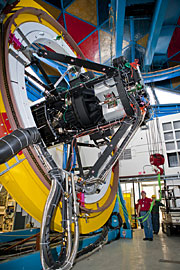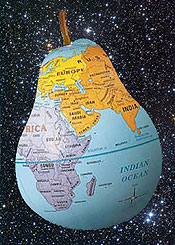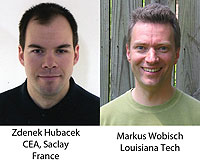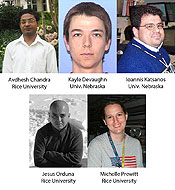|
Have a safe day!
Thursday, April 21
2 p.m.
LHC Physics Center Topic of the Week Seminar - Sunrise, WH11NE
Speaker: Charles Plager, University of California, Los Angeles
Title: Top Quark Physics: Past, Present, and Future – Part 2
2:30 p.m.
Theoretical Physics Seminar - Curia II
Speaker: Josh Erlich, College of William and Mary
Title: Phases of Holographic QCD
3:30 p.m.
DIRECTOR'S COFFEE BREAK - 2nd Flr X-Over
THERE WILL BE NO ACCELERATOR PHYSICS AND TECHNOLOGY SEMINAR TODAY
Friday, April 22
3:30 p.m.
DIRECTOR'S COFFEE BREAK - 2nd Flr X-Over
4 p.m.
Joint Experimental-Theoretical Physics Seminar - One West
Speaker: Patrick Fox, Fermilab
Title: Hunting for Dark Matter at the Tevatron
Click here for NALCAL,
a weekly calendar with links to additional information.
Upcoming conferences
|
|
Thursday, April 21
- Breakfast: Apple sticks
- Minnesota wild-rice w/chicken
- Tuna melt on nine grain
- *Italian meatloaf
- Chicken casserole
- Buffalo crispy chicken wrap
- Assorted sliced pizza
- Mandarin chicken
*Heart healthy choice
Wilson Hall Cafe Menu
|
|
Friday, April 22
- Closed
Wednesday, April 27
Lunch
- Gingered flank steak
- Sake glazed vegetables
- Rice pudding
Chez Leon Menu
Call x3524 to make your reservation.
|
|
Celebrate Earth Day at ES&H Fair 11:30 a.m.- 1 p.m. today
 |
| Celebrate Earth Day at the ES&H Fair from 11:30 a.m. to 1 p.m. today in the Wilson Hall atrium. |
What does it really mean to be a good steward of the Earth? To get some good ideas, perhaps win an ecological prize, and have fun celebrating with your co-workers, come to the lab-wide, ES&H Section-sponsored Earth Day Fair from 11:30 a.m. to 1 p.m. Thursday, April 21, in the Wilson Hall atrium.
Earth Day aims to create awareness and appreciation for the environment and for Earth-friendly behaviors you can practice at work and home.
Personnel from all around the lab help support the event with their efforts. The following organizations will be on hand to share their missions and Earth-friendly activities: Friends of the Fox River, the Fermilab Sustainable Energy Club, the Fermilab Natural Areas and the Fermilab Ecological Land Management Committee.
|
Dark Energy Camera ready for shipping to Chile
 |
| A replica ring of the top-end of the Blanco telescope allowed technicians at Fermilab to test the
installation of a 570-megapixel
camera and check how camera
parts would function as the
telescope rotates. This testing
significantly reduces the amount
of telescope down time that will
be required during the assembly
in Chile. |
Building and installing one of the world’s largest digital cameras to solve the mystery of dark energy requires the collaboration of scientists and industry from across the globe. The Dark Energy Survey’s combination of survey area and depth will far surpass the scope of previous projects and provide researchers for the first time with four search techniques in one powerful instrument. More than 120 scientists are collaborating to determine the true nature of dark energy, the mysterious force that accelerates the expansion of the universe. Taking images of galaxies from the time the universe was only a few billion years old, the DES will trace the history of the expanding universe roughly three-quarters of the way back to the time of the Big Bang.
But first researchers needed to build the 570-megapixel camera at DOE’s Fermi National Accelerator Laboratory and make sure it works. Nearly all of the camera’s parts made their way to Fermilab for assembly and testing during the last 12 months. The components were assembled and operated on a full-size replica of the front end of the 4-meter Blanco telescope in Chile, built by Fermilab and Argonne National Laboratory. Testing finished successfully in February. During the next few months, physicists will be putting the finishing touches on pieces of the camera and shipping them to the Cerro Tololo Inter-American Observatory in Chile where they will receive another round of tests before installation.
The high-tech supply chain tapped the expertise at four DOE Office of Science national laboratories and more than two dozen institutions and universities in the United States and abroad. More than 120 companies in the United States contributed know-how and parts. Fermilab took the lead in the assembly and testing of the camera and building a cryogenics system several times larger than those used in previous ground-based sky surveys, while Berkeley and Argonne national laboratories played key roles in the camera development.
Read more
|
US budget a taste of battles to come
From Nature News, April 19, 2011
Deal leaves science agencies with less but avoids deep cuts.
Rush Holt calls it "deficit attention disorder". Speaking earlier this month at a science-policy luncheon on Capitol Hill, the New Jersey Democratic congressman and nuclear physicist was reflecting on the fiscal climate that has settled over Washington DC. Last week, the impact of that climate was felt acutely, as Congress passed a federal spending bill that makes the deepest cut ever to the US budget. For scientists employed or supported by government research agencies, the news would seem to be dire. The deal, which President Barack Obama signed into law on 15 April, applies the first significant funding cuts to most of those agencies in a generation — with the strong possibility of deeper cuts to come. Yet, given what might have been, the outcome is a relief to most research advocates.
"The basic-research agencies all did pretty well," says Patrick Clemins, director of the research-and-development budget and policy programme at the American Association for the Advancement of Science in Washington DC.
Read more
|
Neutrons could test Newton's gravity and string theory
From BBC News, April 17, 2011
A pioneering technique using subatomic particles known as neutrons could give microscopic hints of extra dimensions or even dark matter, researchers say.
The idea rests on probing any minuscule variations in gravity as it acts on slow-moving neutrons in a tiny cavity.
A Nature Physics report outlines how neutrons were made to hop from one gravitational quantum state to another.
These quantum jumps can test Newton's theory of gravity - and any variations from it - with unprecedented precision.
The "quantum states" of atoms, light particles known as photons, molecules and even objects big enough to be seen have been extensively studied.
They are called quantum because it takes a packet of energy of a very specific size - a quantum - to create the states.
Read more
|
|
A more precise study of the strong force
 |
|
The Earth is a sphere with a diameter of approximately 8,000 miles. However, if you measure precisely enough, you find that the Earth is slightly pear shaped. The exaggerated figure conveys the basic idea, although the real variation is only about 0.1 percent, which is why the Earth looks spherical to the naked eye. This week’s article describes a similar concept in a DZero measurement.
|
Suppose you needed to know the exact distance between Fermilab and CERN. To first approximation, the Earth is a sphere, so you can take the laboratories’ latitudes and longitudes and work out the distance using high school geometry.
However, if you measure precisely enough, you find that the Earth isn’t perfectly spherical. It is slightly pear shaped and it has mountains. A more precise measurement must take into consideration these finer points.
Similar to calculating distance based on the generally spherical shape of the Earth, we can use simplified physics equations to predict the kinds of collisions we should see at the Tevatron. It turns out that we don’t know how to exactly solve the equations that describe the behavior of the strong force, which governs the behavior of matter in the center of atoms. By using simplified equations, we can predict what happens when the Tevatron beams collide and two quarks or gluons are knocked out of the interaction. However, these approximate equations are unable to give any information about what happens when three particles are created in the collision. This takes place only about 10 percent as often as the more common production of two particles. To calculate this phenomenon of creating three particles, physicists must use an improved approximation, which is analogous to taking into account the small pear-shaped corrections to the shape of the Earth. For four particles, a better approximation still (e.g. mountains) must be used. Each successive approximation is closer to using the full (and currently unsolvable) equations.
In this result, DZero physicists studied collisions in which three jets were produced. When a quark or gluon is created in a collision, it turns into a jet of particles with essentially the same energy and direction of the parent quark or gluon. Because three jets are produced in the above scenario, this collision requires equations that are a more accurate approximation to calculate what is going on. This analysis is an extension of an earlier result. This new measurement gives us a more precise glimpse of the inner workings of the strong force.
- Don Lincoln
 |
|
These physicists performed this analysis.
|
 |
|
Understanding how much beam has been delivered to the experiment is a crucial component of many analyses. These physicists are responsible for the day to day operations of the equipment that makes this measurement possible.
|
|
|